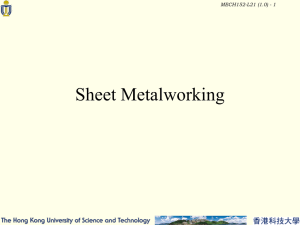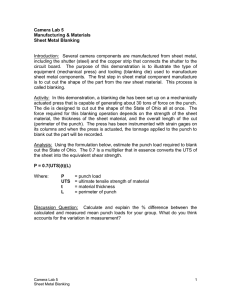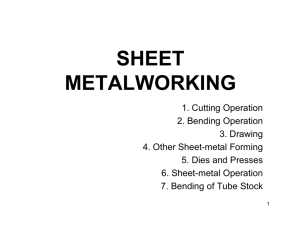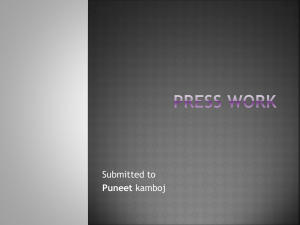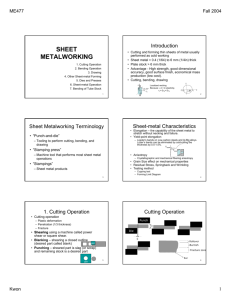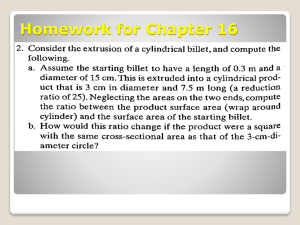Chapter 16 SHEET METALWORKING
advertisement
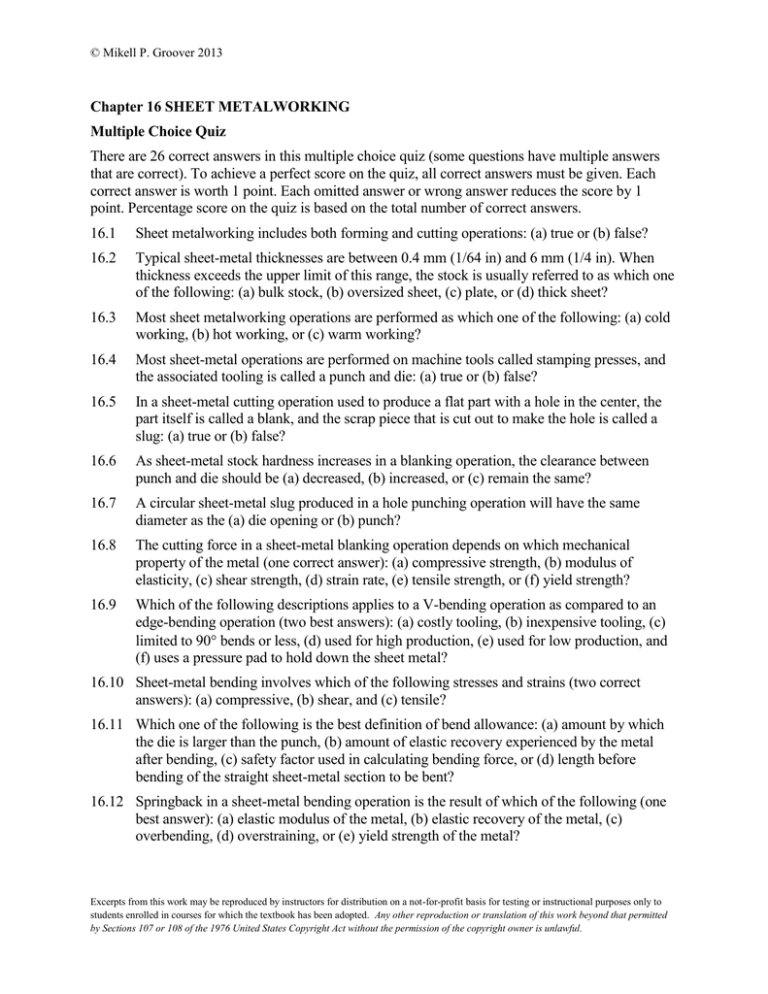
© Mikell P. Groover 2013 Chapter 16 SHEET METALWORKING Multiple Choice Quiz There are 26 correct answers in this multiple choice quiz (some questions have multiple answers that are correct). To achieve a perfect score on the quiz, all correct answers must be given. Each correct answer is worth 1 point. Each omitted answer or wrong answer reduces the score by 1 point. Percentage score on the quiz is based on the total number of correct answers. 16.1 Sheet metalworking includes both forming and cutting operations: (a) true or (b) false? 16.2 Typical sheet-metal thicknesses are between 0.4 mm (1/64 in) and 6 mm (1/4 in). When thickness exceeds the upper limit of this range, the stock is usually referred to as which one of the following: (a) bulk stock, (b) oversized sheet, (c) plate, or (d) thick sheet? 16.3 Most sheet metalworking operations are performed as which one of the following: (a) cold working, (b) hot working, or (c) warm working? 16.4 Most sheet-metal operations are performed on machine tools called stamping presses, and the associated tooling is called a punch and die: (a) true or (b) false? 16.5 In a sheet-metal cutting operation used to produce a flat part with a hole in the center, the part itself is called a blank, and the scrap piece that is cut out to make the hole is called a slug: (a) true or (b) false? 16.6 As sheet-metal stock hardness increases in a blanking operation, the clearance between punch and die should be (a) decreased, (b) increased, or (c) remain the same? 16.7 A circular sheet-metal slug produced in a hole punching operation will have the same diameter as the (a) die opening or (b) punch? 16.8 The cutting force in a sheet-metal blanking operation depends on which mechanical property of the metal (one correct answer): (a) compressive strength, (b) modulus of elasticity, (c) shear strength, (d) strain rate, (e) tensile strength, or (f) yield strength? 16.9 Which of the following descriptions applies to a V-bending operation as compared to an edge-bending operation (two best answers): (a) costly tooling, (b) inexpensive tooling, (c) limited to 90 bends or less, (d) used for high production, (e) used for low production, and (f) uses a pressure pad to hold down the sheet metal? 16.10 Sheet-metal bending involves which of the following stresses and strains (two correct answers): (a) compressive, (b) shear, and (c) tensile? 16.11 Which one of the following is the best definition of bend allowance: (a) amount by which the die is larger than the punch, (b) amount of elastic recovery experienced by the metal after bending, (c) safety factor used in calculating bending force, or (d) length before bending of the straight sheet-metal section to be bent? 16.12 Springback in a sheet-metal bending operation is the result of which of the following (one best answer): (a) elastic modulus of the metal, (b) elastic recovery of the metal, (c) overbending, (d) overstraining, or (e) yield strength of the metal? Excerpts from this work may be reproduced by instructors for distribution on a not-for-profit basis for testing or instructional purposes only to students enrolled in courses for which the textbook has been adopted. Any other reproduction or translation of this work beyond that permitted by Sections 107 or 108 of the 1976 United States Copyright Act without the permission of the copyright owner is unlawful. © Mikell P. Groover 2013 16.13 Which of the following are variations of sheet-metal bending operations (two best answers): (a) coining, (b) flanging, (c) hemming, (d) ironing, (e) notching, (f) shear spinning, (g) trimming, and (h) tube bending? 16.14 The following are measures of feasibility for several proposed cup-drawing operations. Which of the operations are likely to be feasible (three best answers): (a) DR = 1.7, (b) DR = 2.7, (c) r = 0.35, (d) r = 0.65, (e) t/Db = 0.5%, and (f) t/Db = 2%, where DR = drawing ratio, r = reduction, t = stock thickness, and Db = blank diameter? 16.15 The holding force in drawing is most likely to be (a) greater than, (b) equal to, or (c) less than the maximum drawing force? 16.16 Which one of the following processes uses a thick rubber pad to form sheet metal over a positive form block: (a) embossing, (b) Guerin process, (c) hydroforming, (d) lancing, or (e) stretch forming? 16.17 Which one of the following stamping dies is the most complicated: (a) blanking die, (b) combination die, (c) compound die, (d) edge-bending die, (e) progressive die, or (f) V-bending die? 16.18 In a blanking die, the device that clears the sheet metal from the punch after blanking is called which one of the following: (a) clearance device, (b) punch holder, (c) stop, (d) stripper, or (e) upper shoe? 16.19 Which one of the following press types is usually associated with the highest production rates in sheet-metal-stamping operations: (a) adjustable bed, (b) open back inclinable, (c) press brake, (d) solid gap, or (e) straight-sided? 16.20 Which of the following processes are classified as high-energy-rate forming processes (two best answers): (a) electrochemical bending, (b) electromagnetic forming, (c) electron beam deep drawing, (d) explosive forming, (e) Guerin process, (f) hydroforming, (g) redrawing, and (h) shear spinning? Excerpts from this work may be reproduced by instructors for distribution on a not-for-profit basis for testing or instructional purposes only to students enrolled in courses for which the textbook has been adopted. Any other reproduction or translation of this work beyond that permitted by Sections 107 or 108 of the 1976 United States Copyright Act without the permission of the copyright owner is unlawful.
